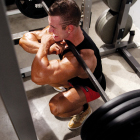Q: I understand you are dogmatically against box squats. What about using them to help peak for athletic competitions to keep the legs fresh, or to give the lower back a break from full squats?
 A: I wouldn’t say that I’m dogmatically against box squats but that I consider them to have limited value. Obviously, they are very valuable for powerlifters, and Louie Simmons, who believes in this exercise, has produced enough 1,000-pound squatters from his lifting stables to prove it.
A: I wouldn’t say that I’m dogmatically against box squats but that I consider them to have limited value. Obviously, they are very valuable for powerlifters, and Louie Simmons, who believes in this exercise, has produced enough 1,000-pound squatters from his lifting stables to prove it.
As for the idea of keeping the legs fresh, simply reduce the volume of squats by keeping the intensity high—it’s the volume, not so much the intensity, that causes overtraining. Let’s say your big game is on Saturday. You might do five to eight sets of squats on Monday and on Thursday do only two to three sets. I know of one Division I college football team that used this system, and their players would often make personal records in squats and power cleans during the season.
In my career I’ve found that box squats tend to lead to all sorts of problems with the hips and lower back. The related problems may take years to show up—box squats were introduced only about 20 years ago, and it’s the guys in their 30s who have done a lot of box squatting who are starting to show up with a lot of problems in the hips and the sacroiliac joint. Because it’s a relatively new exercise, we’re only now starting to see the negative effects.
The same can be said about brushing your teeth. Not brushing your teeth once is not going to give you cavities, but after a long period of time the cavities will develop. Similarly, although you may not experience the bad effects of box squatting immediately, if you include these as a regular part of your training, ultimately the bad effects will come. As for the lower back, those who perform this exercise often use too much weight and start bouncing off the box, and that can seriously injure the lower back.
Another problem I’ve found with box squatting is that it tends to shorten the piriformis muscle because you’re not working it throughout its full range of motion. Tightness in the piriformis is often associated with problems with the sciatic nerve. Think of the piriformis as a glute muscle that externally rotates the upper-thigh bone—so that the toes are pointed outward—and moves it laterally, away from the body. I’ve found that athletes who excel in sports in which there is a lot of sudden changing of directions, such as soccer and American football, have good flexibility in this muscle.
Editor’s note: Charles Poliquin is recognized as one of the world’s most suc-cessful strength coaches, having coached Olympic med-alists in 12 different sports, including the U.S. women’s track-and-field team for the 2000 Olympics. He’s spent years researching European journals (he’s fluent in English, French and German) and speaking with other coaches and scientists in his quest to optimize training methods. For more on his books, seminars and methods, visit www.CharlesPoliquin.com. Also, see his ad on the opposite page. IM




















You must be logged in to post a comment Login